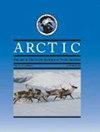Kittlitz的小海鱼的季节分布和从阿拉斯加湾到北冰洋的繁殖后迁徙
IF 0.8
4区 地球科学
Q4 ENVIRONMENTAL SCIENCES
引用次数: 1
摘要
Kittlitz的小海雀(Brachyramphus brevirostris)在夏季在冰川消融或最近冰川消融(后威斯康星州)的景观中筑巢。它们在邻近的海水中觅食,尤其是那些受冰川融水影响的水域。人们对它们在繁殖季节之外的活动和分布知之甚少。为了确定小海豚繁殖后的迁徙,我们于2009年5月至7月在阿拉斯加湾和阿留申群岛的海上捕获了47只小海豚,并对27只从捕获区迁移的小海豚进行了跟踪。幼鱼繁殖后向白令海迁移,移动时间短(平均2天),中间有短暂停留(平均1天)。平均移动速度为79.4 km d-1 (83.5 SD, 449.1最大值)。5月份在威廉王子湾被标记的5只基特利茨小须鲸在8月份迁徙到白令海,4只继续向北迁徙到北冰洋,记录了2500 - 4000公里的旅程。在8月下旬到9月期间,许多鸟类在阿拉斯加半岛或白令海东部的海岸度过了2-3周,几乎没有活动,也是基本蜕皮的前阶段。船上的调查,其中许多是与我们的遥测研究同时进行的,证实了大量的基特利茨小须鲸在秋季迁徙到北冰洋。他们还发现,一些鸟类在返回夏季繁殖地之前,会在白令海与冰缘、冰沼或边缘冰带栖息地有关的地方度过冬季和春季。我们的结论是,该物种的最佳特征是亚北极和北极物种,这对未来的风险评估和减轻威胁具有影响。本文章由计算机程序翻译,如有差异,请以英文原文为准。
Kittlitz’s Murrelet Seasonal Distribution and Post-breeding Migration from the Gulf of Alaska to the Arctic Ocean
Kittlitz’s Murrelets (Brachyramphus brevirostris) nest during summer in glaciated or recently deglaciated (post-Wisconsin) landscapes. They forage in adjacent marine waters, especially those influenced by glacial meltwater. Little is known of their movements and distribution outside the breeding season. To identify post-breeding migrations of murrelets, we attached satellite transmitters to birds (n = 47) captured at sea in the Gulf of Alaska and Aleutian Islands during May – July 2009 – 15 and tracked 27 birds that migrated from capture areas. Post-breeding murrelets migrated toward the Bering Sea, with short periods of movement (median 2 d) separated by short stopovers (median 1 d). Travel speeds averaged 79.4 km d-1 (83.5 SD, 449.1 maximum). Five Kittlitz’s Murrelets tagged in Prince William Sound in May migrated to the Bering Sea by August and four continued north to the Arctic Ocean, logging 2500 – 4000 km of travel. Many birds spent 2‒3 weeks with little movement along coasts of the Alaska Peninsula or eastern Bering Sea during late August through September, also the pre-basic molt period. Ship-based surveys, many of which were conducted concurrently with our telemetry studies, confirmed that substantial numbers of Kittlitz’s Murrelets migrate into the Arctic Ocean during autumn. They also revealed that some birds spend winter and spring in the Bering Sea in association with ice-edge, polynya, or marginal ice zone habitats before returning to summer breeding grounds. We conclude that this species is best characterized as a sub-Arctic and Arctic species, which has implications for future risk assessments and threat mitigation.
求助全文
通过发布文献求助,成功后即可免费获取论文全文。
去求助
来源期刊

Arctic
地学-环境科学
CiteScore
2.30
自引率
0.00%
发文量
51
审稿时长
6-12 weeks
期刊介绍:
Arctic is a peer-reviewed, primary research journal that publishes the results of scientific research
from all areas of Arctic scholarship. Original scholarly papers in the physical, social, and biological
sciences, humanities, engineering, and technology are included, as are book reviews,
commentaries, letters to the editor, and profiles of significant people, places, or events of northern
interest
 求助内容:
求助内容: 应助结果提醒方式:
应助结果提醒方式:


